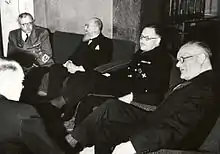European Confederation
European Confederation (German: Europäischer Staatenbund) was a political institution of European unity, part of a wider restructuring (Neuordnung), proposed by German Foreign Minister Joachim von Ribbentrop in March 1943. The plan was rejected by Führer Adolf Hitler.

Some historians have argued that the concept was primarily a propaganda tool, others that there was genuine enthusiasm for European unity among Nazi and Fascist political leaders and intellectuals, as the references to this concept were made in secret government memoranda and conversations.[1]
Background
Certain individuals of the German Foreign Ministry were interested in the "European question", and collaborated with the Auslandswissenschaftliches Institut (DAWI; German Institute for Foreign Studies) on securing a decision on the matter.[2] Influential Europe planners were Werner Daitz, Franz Six and Karl Megerle, who presented papers and studies on the intellectual foundations of a united Europe under Nazi German leadership.[2]
After a number of preliminary studies and drafts, a memorandum was submitted in March 1943, which outlined the steps needed to formalize the Confederation.[2] On April 5, 1943, Ribbentrop issued instructions for the establishment of a "European Committee" (German: Europa-Ausschuß) of 14 diplomats in the Foreign Ministry, which had the task of "the collection of material and the preparation of data to be used for the future settlement of the New European Order after the war has ended."[3]
Planning

Ribbentrop envisioned that as soon as Germany had gained significant military victory, the Heads of States concerned would be invited to a safe meeting-place (away from the reach of Allied bombers) such as Salzburg (perhaps at Klessheim Palace) or Vienna, where the instrument for bringing the Confederation into being would be solemnly signed.[4] The states in question were Germany, Italy, France, Denmark, Norway, Finland, Slovakia, Hungary, Romania, Bulgaria, Croatia, Serbia and Greece. Spain's participation was anticipated but uncertain in the view of the Spanish neutrality during World War II.[4] The March 1943 memorandum states that if any other states were established in territories currently occupied by Germany, these too would be invited to join.[4] Sweden, Switzerland and Portugal were not expected to join as long as the war continued, but their membership was not seen as being of great importance.[5]

Diplomat Cécil von Renthe-Fink submitted a draft to Ribbentrop which also discussed the possibility of the Baltic countries, Belgium, Netherlands and even Russia under the rule of the Vlasov movement joining the Confederation.[6] The draft also mentions that the admission of countries which were projected to be annexed into Greater Germany would not incite these countries towards nationalism, but would be the first step in drawing them into Germany's political sphere (see Greater Germanic Reich).[6] Poland's admission to the Confederation was according to Renthe-Fink out of the question.[6]
The draft of the Act states that the Confederation was to ensure that wars never again break between European peoples.[7] The members are sovereign states which guarantee the freedom, national character and political independence of other member states.[7]
The organization of the internal affairs of each member state was to be their respective sovereign decision.[7] The member states were to defend the interests of Europe and protect the continent from external enemies.[7] European economy was to reorganized in mutual agreement between the member states, with internal custom and other barriers progressively abolished.[7] Trans-European rail, autobahn, waterway and airline networks were to be developed according to a common plan.[8] The Confederation was to be partly based on earlier diplomatic treaties signed between the Axis powers, the Italian-German Pact of Steel, Tripartite Pact and the Anti-Comintern Pact.[9]
The question of potential territorial adjustments, such as Banat, the Hungarian-Romanian border and Italy's claims to French territory, was not to be dealt with the Act of the Confederation, but was to be issued in separate final peace settlements.[10]
Goal
The project was to assure Germany's allies that their independence would be respected after the war, and also to give impression to the Soviets and the Western Allies that all of Europe stood united in defiance, and that the Allies were not fighting for the liberation of European states, but against European unity, rendering thus American and British anti-German propaganda powerless.[11] A clear call for the confederation would also allow the Germans to recruit more men for the Waffen-SS from the occupied countries, and to force them to bolster their war effort in personal and material spheres.[12] Also, the confederation would deter the neutral countries of Europe from siding with the Allied camp.[11]
Reception among the Axis powers
French (Vichy) Prime Minister Pierre Laval was enthusiastic of the proposal, and in a document to Hitler he wrote that France was ready for territorial sacrifices in Tunisia and Alsace-Lorraine to bring about an "atmosphere of confidence" in Europe.[2] He also stated that France must prepare to join the customs union, and was ready to accept long-term German military occupation of the French Atlantic coast if such is necessary for the protection of the continent.[2] He also hoped that these measures would not exclude Germany and Italy of allowing France to regain "a position appropriate to its continental and colonial past" in the future.[2]
Rejection by Hitler
Adolf Hitler was dismissive of the plan, as his vision of the post-war Europe was one of total German hegemony. Ernst von Weizsäcker recorded in his diaries Hitler's position on the matter. On April 13, 1943 he wrote "Reorganization of Europe: no enthusiasm for this idea on our side; the present jejune communiqué is a compromise between two parties."[10] On May 5, 1943, "The reason why we are not to be drawn into conversation about the "New Order" in Europe is indicated confidentially by the Führer: our neighbours are all our enemies; we must get all we can out of them, but cannot and must not promise them anything."[10]
See also
References
- Baudet (2012), p. 196
- Lipgens & Loth (1985), pp. 50-51
- Lipgens & Loth (1985), p. 127-129
- Lipgens & Loth (1985), p. 123
- Lipgens & Loth (1985), p. 141
- Lipgens & Loth (1985), pp. 140-141
- Lipgens & Loth (1985), p. 127
- Lipgens & Loth (1985), p. 145
- Lipgens & Loth (1985), pp. 133, 148
- Lipgens & Loth (1985), p. 126
- Lipgens & Loth (1985), p. 124-125
- Lipgens & Loth (1985), p. 138
Bibliography
- Baudet, Thierry (2012). The Significance of Borders: Why Representative Government and the Rule of Law require Nation States. Martinus Nijhoff Publishers. ISBN 978-9004228085. Retrieved October 30, 2012.
- Lipgens, Walter; Loth, Wilfried (1985). Documents on the History of European Integration: Continental plans for European union, 1939–1945 (including 250 documents in their original languages on 6 microfiches). Walter de Gruyter. ISBN 978-3110097245. Retrieved October 30, 2012.